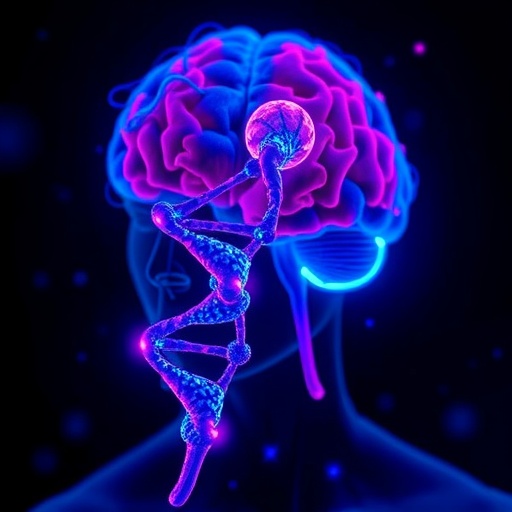In a groundbreaking study published in Translational Psychiatry, researchers have unveiled intricate genetic and neurostructural linkages that connect behavioral inhibition and activation systems to adolescent anxiety and depression. This multifaceted investigation reveals how specific genetic markers and alterations in striatal brain structures converge to modulate emotional and motivational behaviors during a critical developmental window. The findings not only deepen our understanding of the biological underpinnings of mood disorders but also pave the way for innovative interventions targeting adolescent mental health.
Adolescence is characterized by profound neurobiological and psychological changes, often accompanied by an increased vulnerability to affective disorders. Anxiety and depression, the most prevalent mental health issues in this age group, pose significant challenges due to their complex etiologies and heterogeneity. This study tackles these complexities by focusing on the behavioral inhibition system (BIS) and behavioral activation system (BAS), two fundamental neuropsychological mechanisms that regulate responses to aversive and appetitive stimuli respectively. The interplay between these systems has been previously implicated in mood regulation but lacked comprehensive exploration in a genetic and neurostructural context.
The research team employed state-of-the-art imaging techniques alongside genome-wide association studies (GWAS) to dissect the relationships between genetic variants, striatal morphology, and behavioral phenotypes associated with BIS/BAS activity. The striatum, a central component of the basal ganglia, plays a pivotal role in integrating motivational signals and modulating reward-related behaviors. By mapping the striatal structural connectivity in adolescents, the study provides compelling evidence that variations in this neural hub are significantly correlated with alterations in behavioral inhibition and activation tendencies.
Genetic analyses revealed several loci linked to both behavioral traits and striatal configuration. These loci encompass genes implicated in neurotransmitter pathways, synaptic plasticity, and neuronal development, endorsing the hypothesis that genetic predispositions can influence neural circuitry associated with emotional regulation. Importantly, the identification of these genetic markers offers a biological substrate underpinning the observed behavioral patterns and mental health outcomes, bridging the gap between genotype and phenotype.
Moreover, the study’s integration of multimodal data elucidates how the behavioral inhibition system correlates with heightened sensitivity to punishment and threat, which in turn aligns with increased risk for anxiety disorders. Conversely, variations in the behavioral activation system, responsible for reward sensitivity and goal-directed behavior, are linked to depressive symptomatology, underscoring the bidirectional balance between these systems in shaping mood trajectories. This nuanced understanding challenges simplistic dichotomies and calls for bespoke therapeutic approaches tailored to individual neurobehavioral profiles.
A particularly innovative aspect of this work lies in the employment of advanced neuroimaging analytics to quantify striatal structural covariance networks. These networks capture the coordinated developmental patterns of brain regions, reflecting underlying genetic influences on brain morphology. The findings suggest that atypical connectivity within these striatal networks can serve as early biomarkers for anxiety and depression, offering valuable prognostic information for clinical practice.
The implications extend beyond diagnosis, as the identified genetic and neurostructural markers provide promising targets for pharmacological and behavioral interventions. By modulating specific pathways within the BIS/BAS framework, future treatments could achieve enhanced efficacy and specificity, mitigating the onset and progression of adolescent mood disorders. This aligns with a growing trend in precision psychiatry, emphasizing the tailoring of interventions based on individualized biological and psychological profiles.
Furthermore, the study highlights the critical developmental window adolescence represents for intervention, given the dynamic plasticity of the striatum during this period. The ability to detect early deviations in striatal structure and function could inform preventive strategies, potentially altering the course of vulnerability before full-blown clinical manifestations occur. This proactive approach redefines mental health care paradigms, emphasizing early detection and resilience building.
Crucially, the multidisciplinary methodology underscores the value of integrative neuroscience in unraveling complex psychiatric phenomena. By converging genetics, neuroimaging, and behavioral assessment, the research transcends traditional siloed approaches, fostering a holistic appreciation of the multifactorial origins of anxiety and depression. Such comprehensive strategies are essential in addressing the heterogeneity that characterizes adolescent affective disorders.
The research also provokes intriguing questions regarding the environmental modulation of these genetic and neural factors. While the study predominantly focuses on intrinsic biological determinants, it sets the stage for subsequent investigations into gene-by-environment interactions that shape behavioral outcomes. Understanding how external stressors impact the BIS/BAS and striatal architecture could further refine risk models and therapeutic approaches.
Ethical considerations arise as genetic information increasingly informs mental health diagnosis and treatment. The translation of such findings into clinical use demands careful attention to privacy, consent, and the psychosocial ramifications of genetic risk profiling. Ensuring equitable access to emerging precision medicine tools remains paramount to avoid exacerbating existing disparities in mental health care.
In conclusion, this seminal work offers a compelling narrative linking genetic substrates and striatal circuitry to behavioral regulation systems that govern anxiety and depression in adolescents. By delineating these pathways, the study advances the frontier of neuropsychiatric research and sets a precedent for integrative, biology-driven mental health strategies. As we navigate the complexities of adolescent mental illness, such pioneering research offers hope for more effective, personalized interventions that can transform lives.
Subject of Research: Genetic and striatal structural connections underpinning behavioral inhibition/activation systems and their relationship to adolescent anxiety and depression.
Article Title: Genetic and striatal structural connection linking behavioral inhibition/activation system to adolescent anxiety and depression.
Article References:
Lou, J., Tian, X., Sun, Y. et al. Genetic and striatal structural connection linking behavioral inhibition/activation system to adolescent anxiety and depression.
Transl Psychiatry 15, 451 (2025). https://doi.org/10.1038/s41398-025-03687-8
Image Credits: AI Generated
DOI: https://doi.org/10.1038/s41398-025-03687-8




